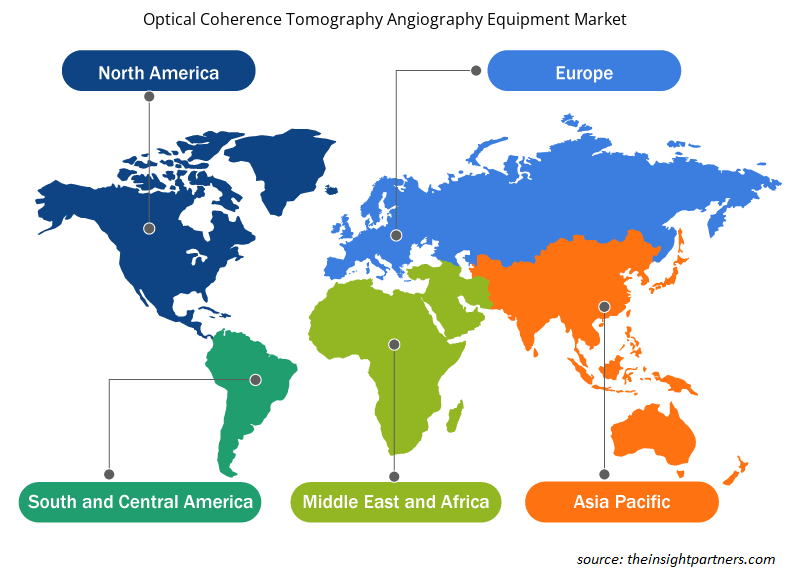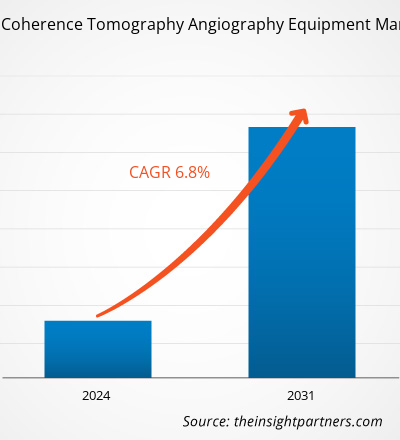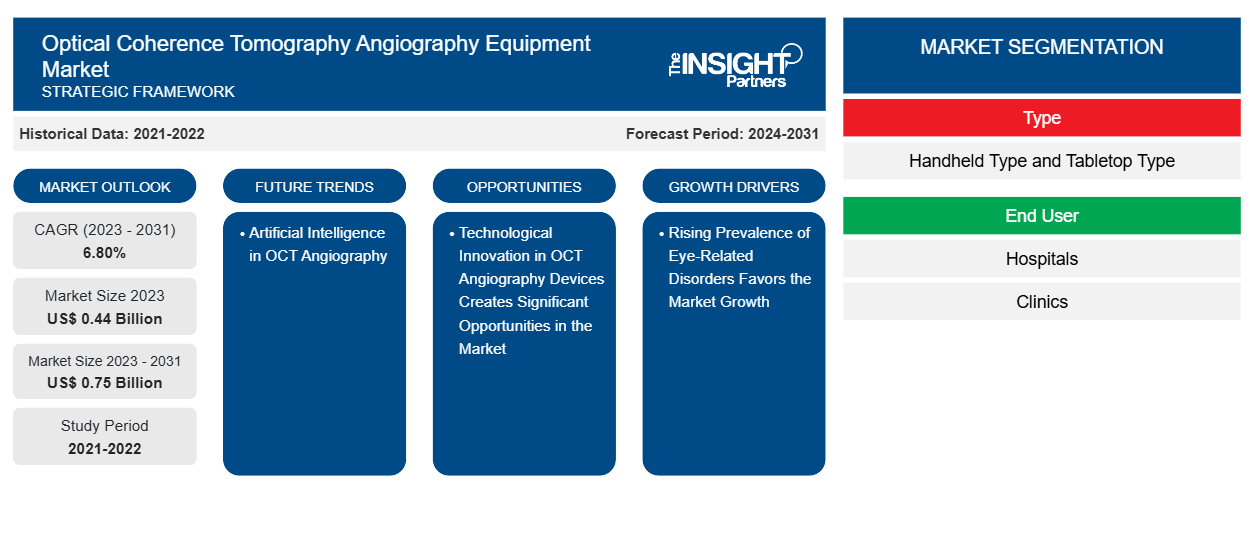光学相干断层扫描血管造影设备市场规模预计将从 2023 年的 4.4 亿美元增至 2031 年的 7.5 亿美元。预计 2023-2031 年市场复合年增长率为 6.80%。OCT血管造影中的人工智能可能仍将是市场的主要趋势。
光学相干断层扫描血管造影设备市场分析
使用技术治疗疾病的情况越来越多。医疗保健专业人员越来越多地采用 OCT血管造影等创新技术,这些技术具有系统和软件方面的进步。因此,消费者对小工具创新的需求不断增长将支持市场扩张。此外,越来越多的市场参与者和眼部疾病的流行促使这些参与者采用尖端技术来制造复杂的 OCT 成像设备,这有望刺激市场扩张。此外,预测期内亚太医疗器械行业的技术进步不断进步,可能会影响市场扩张。此外,由于视网膜疾病的发病率不断上升,不久的将来可能会有更多的增长前景。
光学相干断层扫描血管造影设备市场概况
青光眼是导致 60 岁以上成年人失明的主要原因之一。超过 600 万 50 岁及以上的成年人因年龄相关性黄斑变性、视网膜脱落和糖尿病视网膜病变等原因而失明。此外,与年龄相关的眼部疾病是美国大多数失明和低视力病例的原因。现代化的医疗设施和改善的医疗服务提高了美国、英国、加拿大、日本等发达国家以及中国、印度、韩国等发展中国家的预期寿命。这些因素导致这些地区老年人口增加。世界卫生组织 (WHO) 在 2018 年 2 月发布的数据预测老年人口将从 2015 年的 12% 激增至 2050 年的 22%。
此外,不到 80% 的增长可归因于发展中国家和欠发达国家。老年性黄斑变性 (AMD) 是由于各种眼部疾病的发病率随年龄增长而增加所致。因此,老龄人口可能会患上各种需要诊断的视网膜疾病,因此对光学相干断层扫描血管造影设备的需求也随之增加。
定制此报告以满足您的需求
您可以免费定制任何报告,包括本报告的部分内容、国家级分析、Excel 数据包,以及为初创企业和大学提供优惠和折扣
-
获取此报告的关键市场趋势。这个免费样品将包括数据分析,从市场趋势到估计和预测。
光学相干断层扫描血管造影设备市场驱动因素和机遇
眼部疾病患病率上升有利于市场增长
糖尿病视网膜病变、青光眼、老年性黄斑变性、眼组织胞浆菌病、视网膜静脉阻塞以及视网膜裂孔和脱离都是眼部疾病和状况。高血糖水平会损害和改变视网膜中的血管,导致糖尿病视网膜病变(DR)。这些血管肿胀、渗漏或闭合可能会阻碍血流。罕见的是,视网膜表面会出现异常的新血管。这些改变可能会损害个人的视力。NCBI文章指出,到 2045 年,全球将有大约 1.605 亿成年人患有 DR,高于 2020 年的大约 1.0312 亿。
此外,DR 是最常见的糖尿病眼病,也是美国成人失明的主要原因。根据美国国家眼科研究所的数据,预计 2010 年至 2050 年间,患有 DR 的美国人数量将从 770 万增加到 1460 万,即增长一倍。到 2040 年,全球糖尿病患者将超过 1.5 亿,这可能会导致患糖尿病视网膜病变和视力障碍的人数增加。正因为如此,医院和影像中心对 OCT 设备的使用有所增加,推动了光学相干断层扫描血管造影设备市场的增长。
OCT血管造影设备的技术创新为市场创造了巨大的机遇
OCT的产品开发和技术突破为市场扩张提供了一个有利可图的机会。通过高效的研究和开发程序,OCT血管造影有可能治疗常见疾病,如AMD中的脉络膜 新生血管、糖尿病视网膜病变中的微动脉瘤和缺血、中央和分支视网膜静脉的阻塞和异常以及视神经血管异常。马萨诸塞大学眼科系的科学家正在努力寻找新的信息,以帮助我们更好地了解常见疾病并更有效地治疗患者。市场参与者强调提供有助于市场扩张的高科技产品。由于最近的技术进步,OCTA成像变得更好。凭借对视网膜微血管的无创成像,蔡司AngioPlex OCT血管造影开创了眼部护理的新时代,并提高了诊断、治疗和管理青光眼等视网膜疾病的标准。AngioPlex使用单次非侵入性扫描来可视化血管和结构数据。AngioPlex使用单次扫描简便性和 FastTrac 扫描以最高分辨率捕获图像,从而最大限度地减少眨眼和其他眼球运动造成的伪影,同时又不影响患者吞吐量。同样,还会测量血管密度、脉络膜和外层视网膜中的非流动区域以及Optovue , Inc.的AngioAnalytics 。这些数据有助于通过评估视网膜和视神经乳头血管的改变来追踪治疗效果和管理病程。HH -OCT-A手持式 OCT血管造影系统可促进即时护理和纵向 OCT血管造影成像,并为开发视网膜血管系统和儿科视网膜疾病提供新的视角。这些系统包括一个用于对口腔粘膜进行成像的手持式探头、两个用于对成人进行成像的非接触式 OCT 系统以及一个用于在EUA期间或手术后对婴儿进行成像的接触式系统。因此,在预测期内,由于这些技术进步,全球光学相干断层扫描血管造影设备市场预计将增长更快。
光学相干断层扫描血管造影设备市场报告细分分析
有助于得出光学相干断层扫描血管造影设备市场分析的关键部分是类型和最终用户。
- 根据类型,光学相干断层扫描血管造影设备市场分为手持式和台式。台式设备在 2023 年占据了最大的市场份额。
- 根据最终用户,市场分为医院、诊所和其他。医院部门在 2023 年占据了相当大的市场份额。
光学相干断层扫描血管造影设备市场份额分析(按地区)
光学相干断层扫描血管造影设备市场报告的地理范围主要分为五个区域:北美、亚太、欧洲、中东和非洲、南美和中美。
北美光学相干断层扫描血管造影设备市场分为美国、加拿大和墨西哥。越来越多的技术进步和不断增加的研发活动预计将加速市场的增长。此外,大型市场参与者和视网膜疾病发病率的上升推动了该地区市场的发展。人口老龄化、眼部疾病患病率的上升以及市场参与者的发展支持了光学相干断层扫描血管造影设备的日益普及。老年人口的增加是推动市场增长的因素之一。据报道,美国有超过 4600 万 65 岁及以上的老年人,预计到 2050 年将达到 9000 万。2020 年至 2030 年期间,当婴儿潮最后一批人口达到 65 岁时,老年人口预计将增加近 1800 万。到 2040 年,大约五分之一的美国人将年满 65 岁或以上,而 2000 年这一数字约为八分之一。根据 CDC 的报告,2015 年,美国约有 300 万 40 岁或以上的人患有视力障碍,100 万人失明。超过 800 万人因未矫正的屈光不正而患有视力障碍。由于美国人口老龄化以及糖尿病等慢性病预计增加,预计到 2050 年这些数字将翻一番。失明和视力障碍的主要原因主要是与年龄相关的眼部疾病,例如糖尿病视网膜病变、老年性黄斑变性 (AMD) 和青光眼。因此,老年人口中眼部疾病负担的增加有利于整个地区使用先进的眼部护理和意识计划,以支持光学相干断层扫描血管造影设备市场的增长。
光学相干断层扫描血管造影设备市场区域洞察
Insight Partners 的分析师已详尽解释了预测期内影响光学相干断层扫描血管造影设备市场的区域趋势和因素。本节还讨论了北美、欧洲、亚太地区、中东和非洲以及南美和中美洲的光学相干断层扫描血管造影设备市场细分和地理位置。

- 获取光学相干断层扫描血管造影设备市场的区域特定数据
光学相干断层扫描血管造影设备市场报告范围
| 报告属性 | 细节 |
|---|---|
| 2023 年的市场规模 | 4.4亿美元 |
| 2031 年市场规模 | 7.5亿美元 |
| 全球复合年增长率(2023 - 2031) | 6.80% |
| 史料 | 2021-2022 |
| 预测期 | 2024-2031 |
| 涵盖的领域 |
按类型
|
| 覆盖地区和国家 |
北美
|
| 市场领导者和主要公司简介 |
|
光学相干断层扫描血管造影设备市场参与者密度:了解其对业务动态的影响
光学相干断层扫描血管造影设备市场正在快速增长,这得益于终端用户需求的不断增长,这些需求源于消费者偏好的不断变化、技术进步以及对产品优势的认识不断提高等因素。随着需求的增加,企业正在扩大其产品范围,进行创新以满足消费者需求,并利用新兴趋势,从而进一步推动市场增长。
市场参与者密度是指在特定市场或行业内运营的企业或公司的分布情况。它表明在给定市场空间中,相对于其规模或总市场价值,有多少竞争对手(市场参与者)存在。
在光学相干断层扫描血管造影设备市场运营的主要公司有:
- 尼德克有限公司
- 卡尔蔡司公司
- OPTOVUE 股份有限公司
- 佳能公司
- OPTOPOL 技术 SP.Z OO
- 爱尔康公司
免责声明:上面列出的公司没有按照任何特定顺序排列。

- 获取光学相干断层扫描血管造影设备市场顶级关键参与者概览
光学相干断层扫描血管造影设备市场新闻和最新发展
光学相干断层扫描血管造影设备市场通过收集一级和二级研究后的定性和定量数据进行评估,其中包括重要的公司出版物、协会数据和数据库。光学相干断层扫描血管造影设备市场的一些发展如下所列:
- NIDEK CO., LTD. 是眼科、验光和镜片磨边设备设计、制造和分销领域的全球领导者,该公司很高兴宣布推出 RS-1 Glauvas 光学相干断层扫描仪。(来源:NIDEK CO., LTD.,新闻稿,2024 年 6 月)
光学相干断层扫描血管造影设备市场报告覆盖范围和交付成果
“光学相干断层扫描血管造影设备市场规模和预测(2021-2031 年)”报告对以下领域进行了详细的市场分析:
- 光学相干断层扫描血管造影设备市场规模及预测,涵盖范围涵盖的所有关键细分市场的全球、区域和国家层面
- 光学相干断层扫描血管造影设备市场趋势以及市场动态,如驱动因素、限制因素和关键机遇
- 详细的 PEST/波特五力分析和 SWOT 分析
- 光学相干断层扫描血管造影设备市场分析涵盖主要市场趋势、全球和区域框架、主要参与者、法规和最新的市场发展。
- 行业格局和竞争分析,涵盖市场集中度、热图分析、知名参与者以及光学相干断层扫描血管造影设备市场的最新发展
- 详细的公司简介
- 历史分析(2 年)、基准年、预测(7 年)及复合年增长率
- PEST和SWOT分析
- 市场规模、价值/数量 - 全球、区域、国家
- 行业和竞争格局
- Excel 数据集
近期报告
客户评价
购买理由
- 明智的决策
- 了解市场动态
- 竞争分析
- 客户洞察
- 市场预测
- 风险规避
- 战略规划
- 投资论证
- 识别新兴市场
- 优化营销策略
- 提升运营效率
- 顺应监管趋势























 获取免费样品 - 光学相干断层扫描血管造影设备市场
获取免费样品 - 光学相干断层扫描血管造影设备市场